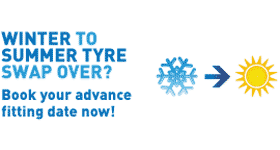Two Pilot Sport Cup 2 Tyre Replacement in Chester for a 911 Carrera 4 GTS
Often found on the GT2/3/Carrera Porsche line-up, these central locking wheel nuts allow a user to quickly change their wheels on the track and also provide improved torque transmission to the wheel.

Below is a general process of removing the nut;
Before we removal of the wheel, the vehicle is jacked up with the parking brake engaged. Alternatively, the car should come with a clamp that stops the wheel from turning whilst the nut is being removed without having the parking brake engaged. This is optional for the rear but is a must for the front wheels as engaging the parking brake will do nothing to stop these from moving!
Using the supplied cover remover, pop off the cap covering the locking section of the nut. The locking mechanism should be flush with the nut and should be able to be pushed in (and then spring back).
Working in a clear area, we used the breaker bar with the special adaptor installed to loosen the nut. This is then removed from the vehicle and placed to one side. Next, the centering pin is installed onto the exposed spline and the wheel gently removed. Using this centering pin protects the wheel from any damage if dropped onto the hub. But also protects the PCCB (Porsche Ceramic Composite Brake) from any chipping. If chipped, this is a new rotor as they can't be repaired.
With the wheel off, the inspections can begin. Starting with the wheel nut, the spline is inspected for any damage inside and out. The splines should be straight with no gouges, cuts or missing pieces. The grease is also inspected to ensure an even layer is present all round the nut with no high spots. If a high spot is present, this could indicate an incorrectly torqued nut or problem with the nut mating surface (corrosion for example). On the silver cone ring, there should also be no obvious wear marks such as a deep sliver line around the top (narrower) part of the ring.

Next to be inspected will be the hub. Starting at the hub surface, there should be no pitting and should be smooth to the touch. From here, we move forward to the nipples. Again, these should be smooth with no pitting, score marks or high spots. The main inspection will be for the spline and surrounding cover. The grease should go down from the outer end by about 10mm and should be even all around.
Finally, the wheel's central hole should be inspected for any scoring, wear marks or possible high spots.
After the inspection has been complete, all grease is cleaned back from the nut, hubs and central spline then new Aluminium grease is spotted onto the surfaces and spread evenly using a finger. Remember to use gloves as this process is messy! Some manuals along with some vehicles ask for the nut to be taken apart and the internals stripped of grease and re-coated every couple of seasons. But please, check your manual.
Once the parts have been re-lubricated it's time to re-assemble! With the guide pin installed back onto the spline, the wheel is installed with care back onto the hub with the female section of the spline being guided onto the male part. After which the guide is removed, and the locking wheel nut tightened down till the central locking mechanism is flush.
With a clear mind and workspace, we used the Porsche calibrated torque wrench to tighten the nut to 650nm. To ensure good accuracy, the nut is loosened off 1/6th of a turn (or 100nm as marked on the nut) then torqued back to 600nm.

The central locking mechanism should still be flush with the face and should be easily spring back if pushed in.
Finally, the visual cap is re-installed onto the wheel and the car lowered to the floor.
One important thing to note about torquing the wheels is that they must be at ambient temperature. If the vehicle has just come off the track or a spirited drive, the components will be hot and would have expanded. If the wheel nut is torqued to the correct specification, this could actually be an inaccurate reading as the components have not cooled back down. and a technician torques the nuts down, they will be too loose as the metal has expanded. Wait until the wheel and nuts are cool before torqued down to the correct setting!
The above is a generalisation of removing and re-installing these specialist nuts. Depending on the vehicle and the wheels fitted, this procedure may differ with the torque settings being the most crucial part. Please double check your hand-book before proceeding!
If you're looking for a set of new Pilot Sport Cup 2s or need a puncture repair, why not give us a call on 0333 444 5454 or send an enquiry to info@hometyre.co.uk!








HometyreGroup
Join the conversation
on Twitter
Follow us